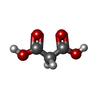[English] 日本語
 Yorodumi
Yorodumi- PDB-7cxf: The ligand-free structure of human PPARgamma LBD C285Y mutant in ... -
+ Open data
Open data
- Basic information
Basic information
| Entry | Database: PDB / ID: 7cxf | ||||||
|---|---|---|---|---|---|---|---|
| Title | The ligand-free structure of human PPARgamma LBD C285Y mutant in the presence of the SRC-1 coactivator peptide | ||||||
 Components Components |
| ||||||
 Keywords Keywords |  TRANSCRIPTION / TRANSCRIPTION /  Nuclear receptor / Nuclear receptor /  ligand binding domain / ligand binding domain /  mutant mutant | ||||||
| Function / homology |  Function and homology information Function and homology informationlabyrinthine layer morphogenesis / regulation of thyroid hormone mediated signaling pathway / positive regulation of transcription from RNA polymerase II promoter by galactose /  prostaglandin receptor activity / regulation of cholesterol transporter activity / negative regulation of connective tissue replacement involved in inflammatory response wound healing / negative regulation of receptor signaling pathway via STAT / MECP2 regulates transcription factors / positive regulation of female receptivity / negative regulation of extracellular matrix assembly ...labyrinthine layer morphogenesis / regulation of thyroid hormone mediated signaling pathway / positive regulation of transcription from RNA polymerase II promoter by galactose / prostaglandin receptor activity / regulation of cholesterol transporter activity / negative regulation of connective tissue replacement involved in inflammatory response wound healing / negative regulation of receptor signaling pathway via STAT / MECP2 regulates transcription factors / positive regulation of female receptivity / negative regulation of extracellular matrix assembly ...labyrinthine layer morphogenesis / regulation of thyroid hormone mediated signaling pathway / positive regulation of transcription from RNA polymerase II promoter by galactose /  prostaglandin receptor activity / regulation of cholesterol transporter activity / negative regulation of connective tissue replacement involved in inflammatory response wound healing / negative regulation of receptor signaling pathway via STAT / MECP2 regulates transcription factors / positive regulation of female receptivity / negative regulation of extracellular matrix assembly / negative regulation of vascular endothelial cell proliferation / negative regulation of cellular response to transforming growth factor beta stimulus / negative regulation of cardiac muscle hypertrophy in response to stress / prostaglandin receptor activity / regulation of cholesterol transporter activity / negative regulation of connective tissue replacement involved in inflammatory response wound healing / negative regulation of receptor signaling pathway via STAT / MECP2 regulates transcription factors / positive regulation of female receptivity / negative regulation of extracellular matrix assembly / negative regulation of vascular endothelial cell proliferation / negative regulation of cellular response to transforming growth factor beta stimulus / negative regulation of cardiac muscle hypertrophy in response to stress /  arachidonic acid binding / positive regulation of low-density lipoprotein receptor activity / positive regulation of adiponectin secretion / lipoprotein transport / negative regulation of sequestering of triglyceride / macrophage derived foam cell differentiation / positive regulation of vascular associated smooth muscle cell apoptotic process / arachidonic acid binding / positive regulation of low-density lipoprotein receptor activity / positive regulation of adiponectin secretion / lipoprotein transport / negative regulation of sequestering of triglyceride / macrophage derived foam cell differentiation / positive regulation of vascular associated smooth muscle cell apoptotic process /  DNA binding domain binding / hypothalamus development / STAT family protein binding / male mating behavior / positive regulation of fatty acid metabolic process / response to lipid / negative regulation of SMAD protein signal transduction / NR1H2 & NR1H3 regulate gene expression to control bile acid homeostasis / LBD domain binding / negative regulation of type II interferon-mediated signaling pathway / negative regulation of cholesterol storage / DNA binding domain binding / hypothalamus development / STAT family protein binding / male mating behavior / positive regulation of fatty acid metabolic process / response to lipid / negative regulation of SMAD protein signal transduction / NR1H2 & NR1H3 regulate gene expression to control bile acid homeostasis / LBD domain binding / negative regulation of type II interferon-mediated signaling pathway / negative regulation of cholesterol storage /  E-box binding / alpha-actinin binding / lipid homeostasis / negative regulation of vascular associated smooth muscle cell proliferation / E-box binding / alpha-actinin binding / lipid homeostasis / negative regulation of vascular associated smooth muscle cell proliferation /  R-SMAD binding / monocyte differentiation / negative regulation of macrophage derived foam cell differentiation / cellular response to low-density lipoprotein particle stimulus / negative regulation of lipid storage / negative regulation of blood vessel endothelial cell migration / R-SMAD binding / monocyte differentiation / negative regulation of macrophage derived foam cell differentiation / cellular response to low-density lipoprotein particle stimulus / negative regulation of lipid storage / negative regulation of blood vessel endothelial cell migration /  estrous cycle / negative regulation of BMP signaling pathway / cellular response to Thyroglobulin triiodothyronine / white fat cell differentiation / negative regulation of mitochondrial fission / Synthesis of bile acids and bile salts / positive regulation of cholesterol efflux / retinoic acid receptor signaling pathway / positive regulation of fat cell differentiation / negative regulation of osteoblast differentiation / estrous cycle / negative regulation of BMP signaling pathway / cellular response to Thyroglobulin triiodothyronine / white fat cell differentiation / negative regulation of mitochondrial fission / Synthesis of bile acids and bile salts / positive regulation of cholesterol efflux / retinoic acid receptor signaling pathway / positive regulation of fat cell differentiation / negative regulation of osteoblast differentiation /  cell fate commitment / positive regulation of DNA binding / BMP signaling pathway / Endogenous sterols / Synthesis of bile acids and bile salts via 27-hydroxycholesterol / Synthesis of bile acids and bile salts via 7alpha-hydroxycholesterol / long-chain fatty acid transport / nuclear retinoid X receptor binding / response to retinoic acid / negative regulation of signaling receptor activity / cell fate commitment / positive regulation of DNA binding / BMP signaling pathway / Endogenous sterols / Synthesis of bile acids and bile salts via 27-hydroxycholesterol / Synthesis of bile acids and bile salts via 7alpha-hydroxycholesterol / long-chain fatty acid transport / nuclear retinoid X receptor binding / response to retinoic acid / negative regulation of signaling receptor activity /  histone acetyltransferase activity / regulation of cellular response to insulin stimulus / Recycling of bile acids and salts / cell maturation / histone acetyltransferase activity / regulation of cellular response to insulin stimulus / Recycling of bile acids and salts / cell maturation /  histone acetyltransferase / cellular response to hormone stimulus / NR1H3 & NR1H2 regulate gene expression linked to cholesterol transport and efflux / epithelial cell differentiation / positive regulation of adipose tissue development / peroxisome proliferator activated receptor signaling pathway / RORA activates gene expression / histone acetyltransferase / cellular response to hormone stimulus / NR1H3 & NR1H2 regulate gene expression linked to cholesterol transport and efflux / epithelial cell differentiation / positive regulation of adipose tissue development / peroxisome proliferator activated receptor signaling pathway / RORA activates gene expression /  lactation / positive regulation of neuron differentiation / Regulation of lipid metabolism by PPARalpha / hormone-mediated signaling pathway / cerebellum development / negative regulation of angiogenesis / response to nutrient / BMAL1:CLOCK,NPAS2 activates circadian gene expression / fatty acid metabolic process / SUMOylation of transcription cofactors / Activation of gene expression by SREBF (SREBP) / negative regulation of miRNA transcription / nuclear receptor coactivator activity / placenta development / response to progesterone / negative regulation of MAP kinase activity / Regulation of PTEN gene transcription / lactation / positive regulation of neuron differentiation / Regulation of lipid metabolism by PPARalpha / hormone-mediated signaling pathway / cerebellum development / negative regulation of angiogenesis / response to nutrient / BMAL1:CLOCK,NPAS2 activates circadian gene expression / fatty acid metabolic process / SUMOylation of transcription cofactors / Activation of gene expression by SREBF (SREBP) / negative regulation of miRNA transcription / nuclear receptor coactivator activity / placenta development / response to progesterone / negative regulation of MAP kinase activity / Regulation of PTEN gene transcription /  transcription coregulator binding / nuclear estrogen receptor binding / transcription coregulator binding / nuclear estrogen receptor binding /  nuclear receptor binding / hippocampus development / negative regulation of smooth muscle cell proliferation / nuclear receptor binding / hippocampus development / negative regulation of smooth muscle cell proliferation /  peptide binding / RNA polymerase II transcription regulatory region sequence-specific DNA binding / negative regulation of transforming growth factor beta receptor signaling pathway / Heme signaling / SUMOylation of intracellular receptors / mRNA transcription by RNA polymerase II peptide binding / RNA polymerase II transcription regulatory region sequence-specific DNA binding / negative regulation of transforming growth factor beta receptor signaling pathway / Heme signaling / SUMOylation of intracellular receptors / mRNA transcription by RNA polymerase IISimilarity search - Function | ||||||
| Biological species |   Homo sapiens (human) Homo sapiens (human) | ||||||
| Method |  X-RAY DIFFRACTION / X-RAY DIFFRACTION /  SYNCHROTRON / SYNCHROTRON /  MOLECULAR REPLACEMENT / Resolution: 2.35 Å MOLECULAR REPLACEMENT / Resolution: 2.35 Å | ||||||
 Authors Authors | Jang, D.M. / Han, B.W. | ||||||
| Funding support |  Korea, Republic Of, 1items Korea, Republic Of, 1items
| ||||||
 Citation Citation |  Journal: To Be Published Journal: To Be PublishedTitle: The ligand-free structure of human PPARgamma LBD Authors: Jang, D.M. / Han, B.W. | ||||||
| History |
|
- Structure visualization
Structure visualization
| Structure viewer | Molecule:  Molmil Molmil Jmol/JSmol Jmol/JSmol |
|---|
- Downloads & links
Downloads & links
- Download
Download
| PDBx/mmCIF format |  7cxf.cif.gz 7cxf.cif.gz | 75 KB | Display |  PDBx/mmCIF format PDBx/mmCIF format |
|---|---|---|---|---|
| PDB format |  pdb7cxf.ent.gz pdb7cxf.ent.gz | 52.2 KB | Display |  PDB format PDB format |
| PDBx/mmJSON format |  7cxf.json.gz 7cxf.json.gz | Tree view |  PDBx/mmJSON format PDBx/mmJSON format | |
| Others |  Other downloads Other downloads |
-Validation report
| Arichive directory |  https://data.pdbj.org/pub/pdb/validation_reports/cx/7cxf https://data.pdbj.org/pub/pdb/validation_reports/cx/7cxf ftp://data.pdbj.org/pub/pdb/validation_reports/cx/7cxf ftp://data.pdbj.org/pub/pdb/validation_reports/cx/7cxf | HTTPS FTP |
|---|
-Related structure data
| Related structure data | 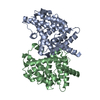 7cxeC  7cxgC 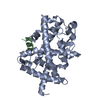 7cxhC 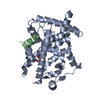 7cxiC 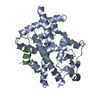 7cxjC 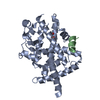 7cxkC  7cxlC  5gtpS S: Starting model for refinement C: citing same article ( |
|---|---|
| Similar structure data |
- Links
Links
- Assembly
Assembly
| Deposited unit | 
| ||||||||
|---|---|---|---|---|---|---|---|---|---|
| 1 |
| ||||||||
| Unit cell |
|
- Components
Components
| #1: Protein |  / PPAR-gamma / Nuclear receptor subfamily 1 group C member 3 / PPAR-gamma / Nuclear receptor subfamily 1 group C member 3Mass: 32340.381 Da / Num. of mol.: 1 Source method: isolated from a genetically manipulated source Source: (gene. exp.)   Homo sapiens (human) / Gene: PPARG, NR1C3 / Production host: Homo sapiens (human) / Gene: PPARG, NR1C3 / Production host:   Escherichia coli (E. coli) / References: UniProt: P37231 Escherichia coli (E. coli) / References: UniProt: P37231 |
|---|---|
| #2: Protein/peptide | Mass: 1905.186 Da / Num. of mol.: 1 / Source method: obtained synthetically / Source: (synth.)   Homo sapiens (human) / References: UniProt: Q15788, Homo sapiens (human) / References: UniProt: Q15788,  histone acetyltransferase histone acetyltransferase |
| #3: Chemical | ChemComp-MLA /  Malonic acid Malonic acid |
| #4: Water | ChemComp-HOH /  Water Water |
| Has ligand of interest | Y |
-Experimental details
-Experiment
| Experiment | Method:  X-RAY DIFFRACTION / Number of used crystals: 1 X-RAY DIFFRACTION / Number of used crystals: 1 |
|---|
- Sample preparation
Sample preparation
| Crystal | Density Matthews: 2.68 Å3/Da / Density % sol: 54.16 % |
|---|---|
Crystal grow | Temperature: 295 K / Method: vapor diffusion, sitting drop / pH: 7 / Details: 2.2 M sodium malonate (pH 7.0) |
-Data collection
| Diffraction | Mean temperature: 100 K / Serial crystal experiment: N |
|---|---|
| Diffraction source | Source:  SYNCHROTRON / Site: PAL/PLS SYNCHROTRON / Site: PAL/PLS  / Beamline: 5C (4A) / Wavelength: 0.9794 Å / Beamline: 5C (4A) / Wavelength: 0.9794 Å |
| Detector | Type: ADSC QUANTUM 270 / Detector: CCD / Date: Nov 14, 2017 |
| Radiation | Protocol: SINGLE WAVELENGTH / Monochromatic (M) / Laue (L): M / Scattering type: x-ray |
| Radiation wavelength | Wavelength : 0.9794 Å / Relative weight: 1 : 0.9794 Å / Relative weight: 1 |
| Reflection | Resolution: 2.35→50 Å / Num. obs: 16225 / % possible obs: 99 % / Redundancy: 5.7 % / CC1/2: 1 / Rmerge(I) obs: 0.053 / Net I/σ(I): 28.21 |
| Reflection shell | Resolution: 2.35→2.39 Å / Redundancy: 5.8 % / Rmerge(I) obs: 0.584 / Mean I/σ(I) obs: 2.64 / Num. unique obs: 778 / CC1/2: 0.874 / % possible all: 97.9 |
- Processing
Processing
| Software |
| |||||||||||||||||||||||||||||||||||||||||||||||||||||||||||||||||||||||||||||||||||||||||||||||||||||||||||||||||||||||||||||||||||||||||||||||||||||||||||
|---|---|---|---|---|---|---|---|---|---|---|---|---|---|---|---|---|---|---|---|---|---|---|---|---|---|---|---|---|---|---|---|---|---|---|---|---|---|---|---|---|---|---|---|---|---|---|---|---|---|---|---|---|---|---|---|---|---|---|---|---|---|---|---|---|---|---|---|---|---|---|---|---|---|---|---|---|---|---|---|---|---|---|---|---|---|---|---|---|---|---|---|---|---|---|---|---|---|---|---|---|---|---|---|---|---|---|---|---|---|---|---|---|---|---|---|---|---|---|---|---|---|---|---|---|---|---|---|---|---|---|---|---|---|---|---|---|---|---|---|---|---|---|---|---|---|---|---|---|---|---|---|---|---|---|---|---|
| Refinement | Method to determine structure : :  MOLECULAR REPLACEMENT MOLECULAR REPLACEMENTStarting model: 5GTP Resolution: 2.35→48.313 Å / Cor.coef. Fo:Fc: 0.916 / Cor.coef. Fo:Fc free: 0.883 / SU B: 7.369 / SU ML: 0.173 / Cross valid method: FREE R-VALUE / ESU R: 0.396 / ESU R Free: 0.269 Details: Hydrogens have been added in their riding positions
| |||||||||||||||||||||||||||||||||||||||||||||||||||||||||||||||||||||||||||||||||||||||||||||||||||||||||||||||||||||||||||||||||||||||||||||||||||||||||||
| Solvent computation | Ion probe radii: 0.8 Å / Shrinkage radii: 0.8 Å / VDW probe radii: 1.2 Å / Solvent model: MASK BULK SOLVENT | |||||||||||||||||||||||||||||||||||||||||||||||||||||||||||||||||||||||||||||||||||||||||||||||||||||||||||||||||||||||||||||||||||||||||||||||||||||||||||
| Displacement parameters | Biso mean: 38.006 Å2
| |||||||||||||||||||||||||||||||||||||||||||||||||||||||||||||||||||||||||||||||||||||||||||||||||||||||||||||||||||||||||||||||||||||||||||||||||||||||||||
| Refinement step | Cycle: LAST / Resolution: 2.35→48.313 Å
| |||||||||||||||||||||||||||||||||||||||||||||||||||||||||||||||||||||||||||||||||||||||||||||||||||||||||||||||||||||||||||||||||||||||||||||||||||||||||||
| Refine LS restraints |
| |||||||||||||||||||||||||||||||||||||||||||||||||||||||||||||||||||||||||||||||||||||||||||||||||||||||||||||||||||||||||||||||||||||||||||||||||||||||||||
| LS refinement shell |
|
 Movie
Movie Controller
Controller


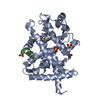
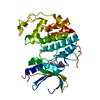

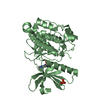


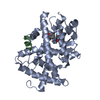

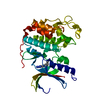

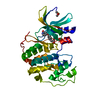
 PDBj
PDBj












